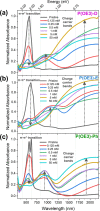Elucidating Design Rules toward Enhanced Solid-State Charge Transport in Oligoether-Functionalized Dioxythiophene-Based Alternating Copolymers
- PMID: 37449957
- PMCID: PMC10375480
- DOI: 10.1021/acsami.3c00053
Elucidating Design Rules toward Enhanced Solid-State Charge Transport in Oligoether-Functionalized Dioxythiophene-Based Alternating Copolymers
Abstract
This study investigates the solid-state charge transport properties of the oxidized forms of dioxythiophene-based alternating copolymers consisting of an oligoether-functionalized 3,4-propylenedioxythiophene (ProDOT) copolymerized with different aryl groups, dimethyl ProDOT (DMP), 3,4-ethylenedioxythiophene (EDOT), and 3,4-phenylenedioxythiophene (PheDOT), respectively, to yield copolymers P(OE3)-D, P(OE3)-E, and P(OE3)-Ph. At a dopant concentration of 5 mM FeTos3, the electrical conductivities of these copolymers vary significantly (ranging between 9 and 195 S cm-1) with the EDOT copolymer, P(OE3)-E, achieving the highest electrical conductivity. UV-vis-NIR and X-ray spectroscopies show differences in both susceptibility to oxidative doping and extent of oxidation for the P(OE3) series, with P(OE3)-E being the most doped. Wide-angle X-ray scattering measurements indicate that P(OE3)-E generally demonstrates the lowest paracrystallinity values in the series, as well as relatively small π-π stacking distances. The significant (i.e., order of magnitude) increase in electrical conductivity of doped P(OE3)-E films versus doped P(OE3)-D or P(OE3)-Ph films can therefore be attributed to P(OE3)-E exhibiting both the highest carrier ratios in the P(OE3) series, along with good π-π overlap and local ordering (low paracrystallinity values). Furthermore, these trends in the extent of doping and paracrystallinity are consistent with the reduced Fermi energy level and transport function prefactor parameters calculated using the semilocalized transport (SLoT) model. Observed differences in carrier ratios at the transport edge (ct) and reduced Fermi energies [η(c)] suggest a broader electronic band (better overlap and more delocalization) for the EDOT-incorporating P(OE3)-E polymer relative to P(OE3)-D and P(OE3)-Ph. Ultimately, we rationalize improvements in electrical conductivity due to microstructural and doping enhancements caused by EDOT incorporation, a structure-property relationship worth considering in the future design of highly electrically conductive systems.
Keywords: charge transport; dioxythiophene polymers; oligoether side chains; solid-state electrical conductivity.
Conflict of interest statement
The authors declare no competing financial interest.
Figures






Similar articles
-
Significant Enhancement of the Electrical Conductivity of Conjugated Polymers by Post-Processing Side Chain Removal.J Am Chem Soc. 2022 Jan 26;144(3):1351-1360. doi: 10.1021/jacs.1c11558. Epub 2022 Jan 10. J Am Chem Soc. 2022. PMID: 35007084
-
Iron(III) Dopant Counterions Affect the Charge-Transport Properties of Poly(Thiophene) and Poly(Dialkoxythiophene) Derivatives.ACS Appl Mater Interfaces. 2022 Jun 29;14(25):29039-29051. doi: 10.1021/acsami.2c03414. Epub 2022 Jun 16. ACS Appl Mater Interfaces. 2022. PMID: 35711091
-
Quantifying Charge Carrier Localization in PBTTT Using Thermoelectric and Spectroscopic Techniques.J Phys Chem C Nanomater Interfaces. 2023 Jun 14;127(25):12206-12217. doi: 10.1021/acs.jpcc.3c01152. eCollection 2023 Jun 29. J Phys Chem C Nanomater Interfaces. 2023. PMID: 37415971 Free PMC article.
-
Effect of Alkyl Side Chain Length on Doping Kinetics, Thermopower, and Charge Transport Properties in Highly Oriented F4TCNQ-Doped PBTTT Films.ACS Appl Mater Interfaces. 2019 Feb 6;11(5):4942-4953. doi: 10.1021/acsami.8b17594. Epub 2019 Jan 28. ACS Appl Mater Interfaces. 2019. PMID: 30644706
-
A Comparative Study of Biomimetic Synthesis of EDOT-Pyrrole and EDOT-Aniline Copolymers by Peroxidase-like Catalysts: Towards Tunable Semiconductive Organic Materials.Front Chem. 2022 Jun 29;10:915264. doi: 10.3389/fchem.2022.915264. eCollection 2022. Front Chem. 2022. PMID: 35844638 Free PMC article.
Cited by
-
Enhanced NIR Electrochromic Properties of Corannulene-(triphenylamine)5 and EDOT-Derived Polymers via Electrochemical Layer-by-Layer Polymerization Compared to Copolymerization.ACS Appl Mater Interfaces. 2025 Feb 19;17(7):10920-10930. doi: 10.1021/acsami.4c21400. Epub 2025 Feb 5. ACS Appl Mater Interfaces. 2025. PMID: 39908537 Free PMC article.
-
Ultrasensitive label-free optical recording of bioelectric potentials using dioxythiophene-based electrochromic polymers.Nat Commun. 2025 Jul 23;16(1):6776. doi: 10.1038/s41467-025-61708-y. Nat Commun. 2025. PMID: 40701952 Free PMC article.
References
-
- Wang S.; Zuo G.; Kim J.; Sirringhaus H. Progress of Conjugated Polymers as Emerging Thermoelectric Materials. Prog. Polym. Sci. 2022, 129, 10154810.1016/j.progpolymsci.2022.101548. - DOI
-
- Chen N.; Pino J.; Katz H. E. A Chemical Kinetics Perspective on Thermoelectric Transport. Appl. Phys. Lett. 2021, 119, 06050310.1063/5.0055367. - DOI
-
- Ponder J. F.; Menon A. K.; Dasari R. R.; Pittelli S. L.; Thorley K. J.; Yee S. K.; Marder S. R.; Reynolds J. R. Conductive, Solution-Processed Dioxythiophene Copolymers for Thermoelectric and Transparent Electrode Applications. Adv. Energy Mater. 2019, 9, 190039510.1002/aenm.201900395. - DOI
LinkOut - more resources
Full Text Sources
Research Materials
Miscellaneous

